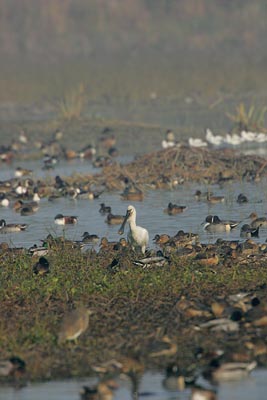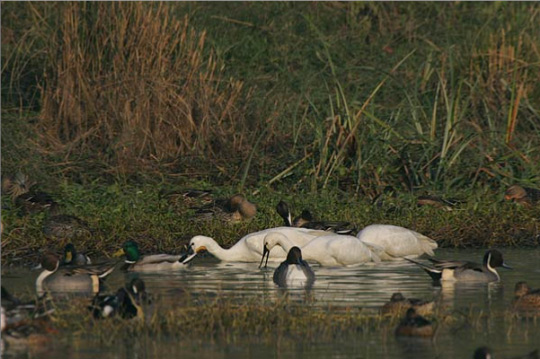Patna Bird Sanctuary - India's Best Kept Birding Secret
©2005 Harri Vainola
©2005 Harri Vainola

Patna, India, January 2005. After spending more than a week around India's more famous wetlands, one drier than the other, I had arrived to the shore of the little known Patna Bird Sanctuary, in Uttar Pradesh. The 2004 monsoon had failed to bring the much needed water to many areas, and the once so rich reservoirs were now alarmingly avoid of life; what had become of the birds ?
Well, here they were, thousands of them; ducks and geese of all descriptions, familiar European species together with their more exotic-looking Asian cousins, accompanied by herons and cormorants. I did not make an effort to count them, but in places I could not see the water from the birds. Having spent time walking on dusty lakebeds, worrying about the faith of the former inhabitants of now dry acacia-trees, I found the sight almost overpowering.
For a considerable time, I just stood there quietly, smiling, until the local sanctuary official pointed to my lens; perhaps I would like to take some photographs ?
I certainly had no trouble of securing the official's services, as I was the only guest at the time. Patna Sanctuary is notoriously little known; not even the local taxi drivers are necessarily familiar by its whereabouts. It is rather ironic, that at the same time, that the visiting birders pay good money to see empty riverbanks elsewhere, Patna has practically no foreign visitors, despite of being full of birds.
The sanctuary is situated near the town of Agra (of Taj Mahal fame); from the hotel district, one should head towards the River Yamuna, and take a left turn after crossing the river. The road to Patna turns right just before a building with a painted Pepsi ad.
There are very few road signs in India, so, in practice, you'd be needing a guide to find your way; here's how to find one:
The owners of Mughal Carpet Company (next to the Hotel Ganga Ratan, Fatehabad Road 198) come from Patna, and know the area very well. Should you be interested in guide services, you may contact them: mughal_carpet@yahoo.com, fax +91 562 2331932.
One should refer to the director, Mr. Adil Khan. Some touting here: They hand-make carpets out of wool, also to order; should you like to have your favourite bird-motif turned into a carpet, just send them a photograph.
Their website can be found here.
The sanctuary is not that far away from the town, but the road is very bumpy; a kamikaze-style indian driver (don't even think about driving yourselves) may negotiate the road in 90 minutes; a more timid (western) person would take at least two hours. Patna is best in the morning, so one should leave the hotel around 7 o'clock, not much earlier, as the road is not considered to be safe at night. In fact, an indian photographer I met in Delhi, told me that they never go there (meaning the rural areas), as they are not safe. However, the road to Patna seemed anything but dangerous in the morning; it was all rather idyllic, with children going to open-air schools in their school outfits, and merchats opening their stores.
The sanctuary has conspicuous signs by the Patna road, and there is ample parking space inside. One is greeted by the officials, and there is a small charge to be paid; I'd suggest a visitor should be generous, as these people are certainly not overpaid by the goverment, and there has to be a considerable number of guards and staff to run the place. This is certainly an important resting area for both domestic and migratory birds, particularly in dry years, so a little sponsoring would not be out of place here.
A foot-path runs from the car park trough a palm grove, to the lakeside, leaving a hindu temple to the left. There are wide, low steps by the shore; this is a best place for a general view, and if one approaches carefully, there will be a great number of birds just in front of you. For a bird-loving person, this would also be a great place to have breakfast.
A scope would also be useful, to scan the great masses of birds in the area. Apart from the beforementioned waterbirds, kingfishers, coucals and wading birds come close here; birds of prey are, of course, also attracted to the area.
Larger birds, such as Painted Storks, can be sometimes seen also in the small island opposite to the steps; this is close enough, to be shot with a long lens.
Well, here they were, thousands of them; ducks and geese of all descriptions, familiar European species together with their more exotic-looking Asian cousins, accompanied by herons and cormorants. I did not make an effort to count them, but in places I could not see the water from the birds. Having spent time walking on dusty lakebeds, worrying about the faith of the former inhabitants of now dry acacia-trees, I found the sight almost overpowering.
For a considerable time, I just stood there quietly, smiling, until the local sanctuary official pointed to my lens; perhaps I would like to take some photographs ?
I certainly had no trouble of securing the official's services, as I was the only guest at the time. Patna Sanctuary is notoriously little known; not even the local taxi drivers are necessarily familiar by its whereabouts. It is rather ironic, that at the same time, that the visiting birders pay good money to see empty riverbanks elsewhere, Patna has practically no foreign visitors, despite of being full of birds.
The sanctuary is situated near the town of Agra (of Taj Mahal fame); from the hotel district, one should head towards the River Yamuna, and take a left turn after crossing the river. The road to Patna turns right just before a building with a painted Pepsi ad.
There are very few road signs in India, so, in practice, you'd be needing a guide to find your way; here's how to find one:
The owners of Mughal Carpet Company (next to the Hotel Ganga Ratan, Fatehabad Road 198) come from Patna, and know the area very well. Should you be interested in guide services, you may contact them: mughal_carpet@yahoo.com, fax +91 562 2331932.
One should refer to the director, Mr. Adil Khan. Some touting here: They hand-make carpets out of wool, also to order; should you like to have your favourite bird-motif turned into a carpet, just send them a photograph.
Their website can be found here.
The sanctuary is not that far away from the town, but the road is very bumpy; a kamikaze-style indian driver (don't even think about driving yourselves) may negotiate the road in 90 minutes; a more timid (western) person would take at least two hours. Patna is best in the morning, so one should leave the hotel around 7 o'clock, not much earlier, as the road is not considered to be safe at night. In fact, an indian photographer I met in Delhi, told me that they never go there (meaning the rural areas), as they are not safe. However, the road to Patna seemed anything but dangerous in the morning; it was all rather idyllic, with children going to open-air schools in their school outfits, and merchats opening their stores.
The sanctuary has conspicuous signs by the Patna road, and there is ample parking space inside. One is greeted by the officials, and there is a small charge to be paid; I'd suggest a visitor should be generous, as these people are certainly not overpaid by the goverment, and there has to be a considerable number of guards and staff to run the place. This is certainly an important resting area for both domestic and migratory birds, particularly in dry years, so a little sponsoring would not be out of place here.
A foot-path runs from the car park trough a palm grove, to the lakeside, leaving a hindu temple to the left. There are wide, low steps by the shore; this is a best place for a general view, and if one approaches carefully, there will be a great number of birds just in front of you. For a bird-loving person, this would also be a great place to have breakfast.
A scope would also be useful, to scan the great masses of birds in the area. Apart from the beforementioned waterbirds, kingfishers, coucals and wading birds come close here; birds of prey are, of course, also attracted to the area.
Larger birds, such as Painted Storks, can be sometimes seen also in the small island opposite to the steps; this is close enough, to be shot with a long lens.
A bird-watching tower can be seen across the lake; I'd recommend against going there, as the path to the right comes too close to the birds, and you'd only be likely to scare them to flight in their hundreds (or, in 1000's). The view from the tower would also be against the sun. It is a better idea to take the path to the left; here it winds behind the vegetatation, and, with some luck, you may come close enough to Sarus Cranes or storks, to have some decent shots. At the end of the path, in the distance to the left, there is an additional pond, which is often literally filled with spoonbills; do not try to approach here, but take a look with a scope instead.
Patna Sanctuary is best during the winter months; most of the birds tend to leave in March. Should you happen to be in the area, I'd definitely recommend it, particularly, if you have trouble finding birds elsewhere, due to the lack of water.
There's likely to be an abundance of birds, and the people are very friendly.
And should you happen to meet the chief wildlife warden, say hi from me.
Patna Sanctuary is best during the winter months; most of the birds tend to leave in March. Should you happen to be in the area, I'd definitely recommend it, particularly, if you have trouble finding birds elsewhere, due to the lack of water.
There's likely to be an abundance of birds, and the people are very friendly.
And should you happen to meet the chief wildlife warden, say hi from me.
This is 1300 mm, full frame, by the island opposite to the steps.

